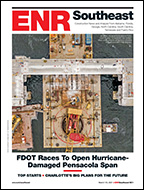Edmonton Bridge Contractors Straighten Buckled Girders


Edmonton city officials are overseeing a review by a structural consultant on what caused four deep steel girders on a new bridge being built over a busy thoroughfare to buckle soon after their placement March 16.
The structure has been stabilized but the project delays are costly, at more than $300,000, and could grow much worse.
Among the factors being examined, city officials say, are bracing that supported the girders, erection procedures and high winds during the weekend when the placement began.
The 40-ton girders were part of a $32-million project that started a year ago. The girder depth is 4.2 meters at their ends, where they are encased on concrete abutments. The bridge span is about 100 meters.
The project’s contracting team, which includes Los Angeles-based AECOM and Calgary-based Graham Construction, placed the girders at 2:15 a.m., but by the next morning the team shut down the busy commuter thoroughfare beneath the steel.
Edmonton-based Supreme Steel’s bridge division is the project steel fabricator and erector.
Graham could not immediately be reached for comment, and officials of AECOM and Supreme Steel declined to comment citing restrictions placed on them by the city.
“We don’t see many of these types of failure,” said Carlos Cruz Noguez, assistant professor of structural engineering at the University of Alberta.
The girder deflection, which Cruz Noguez and other engineers attribute to torsional lateral buckling, is shown in many photos, including a website project camera. “It’s visually amazing,” said Cruz Noguez.
Construction crews stabilized the structure with temporary bracing and supported it with cranes. The deflections, which measured several feet, gradually disappeared. Construction crews then removed the temporary bracing and slipped into place permanent cross-bracing.
More details should become available as the episode is investigated and studied.
A key test was passed yesterday, when Edmonton officials reopened Groat Road, which is crossed by the bridge. The four-lane road is a major east/west artery into the city's downtown business district. Contractual penalties for the road closing of $15,000 a day came to an end.
Must Girders Be Replaced?
Now comes the hard part: Determining whether the girders will need to be replaced and what factor or combination of factors caused the steel to warp.
But that does not necessarily mean the girders can be saved, with the structural consultant hired by the city expected to closely examine and test the 40-ton structures for fractures and other flaws, Cruz Noguez said.
“Further detailed analysis of the girders will be required to determine what corrective measures will be required for the girders,” according to a statement by the city’s engineering department.
In a written description for an Edmonton newspaper, Cruz Noguez said he couldn’t immediately recall any instances of girders that were reused after buckling in such dramatic fashion.


